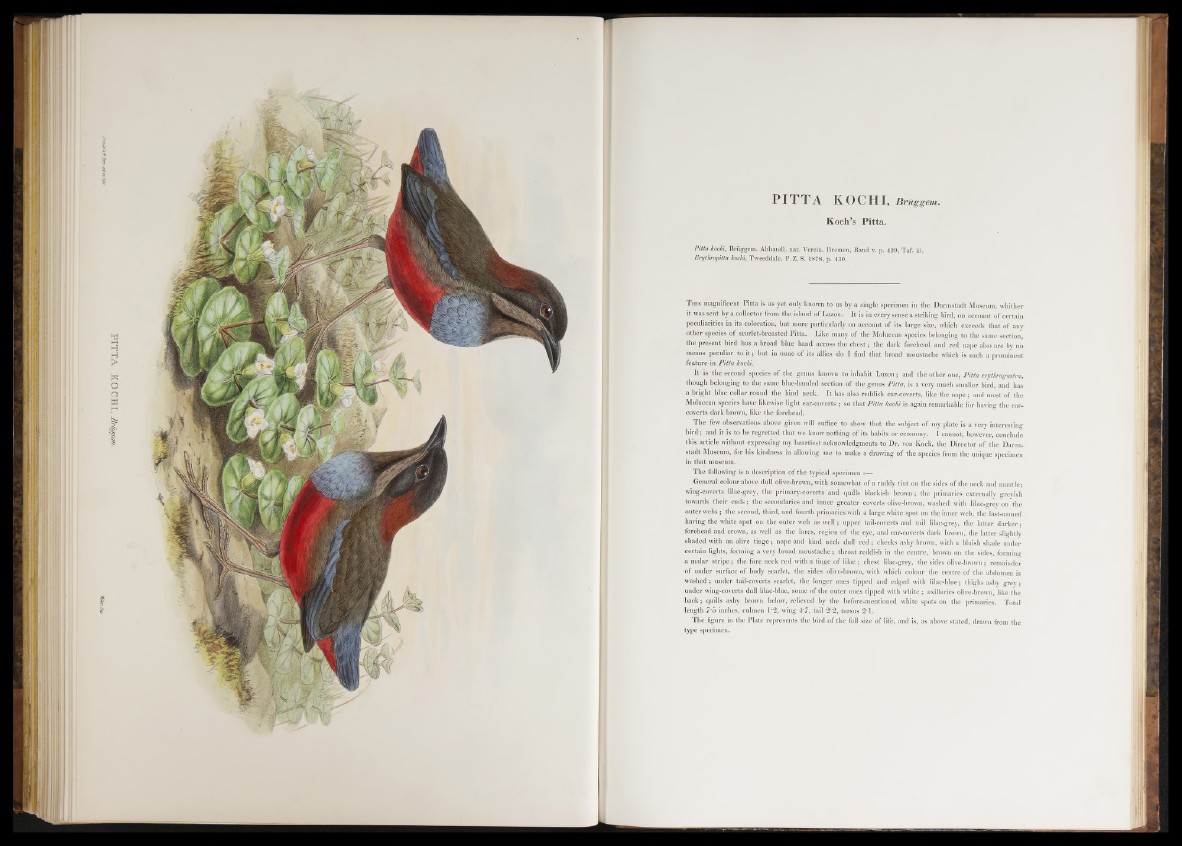
PITTA KOCHI, Bruggem.
Koch’s Pitta.
Pitta kochi, Brüggem. Abhandl. nat. Verein. Bremen, Band v. p. 429, Taf. iii.
Erythropitta kochi, Tweeddale, P. Z. S. 1878, p. 430.
T h is magnificent Pitta is as yet only known to us by a single specimen in the Darmstadt Museum, whither
it was sent by a collector from the island o f Luzon. It is in every sense a striking bird, on account of certain
peculiarities in its coloration, but more particularly on account of its large size, which exceeds that of any
other species of scarlet-breasted Pitta. Like many of the Moluccan species belonging to the same section,
the present bird has a broad blue band across the ch e st; the dark forehead and red nape also are by no
means peculiar to i t ; but in none o f its allies do I find that broad moustache which is such a prominent
feature in Pitta kochi.
It is the second species of the genus known to inhabit Luzon; and the other one, Pitta erythrogastra,
though belonging to the same blue-banded section of the genus Pitta, is a very much smaller bird, and has
a bright blue collar round the hind neck. I t has also reddish ear-coverts, like the n ape; and most of the
Moluccan species have likewise light ear-coverts ; so that Pitta kochi is again remarkable for having the ear-
coverts dark brown, like the forehead.
The few observations above given will suffice to show that the subject of my plate is a very interesting
b ird ; and it is to be regretted that we know nothing of its habits or economy. I cannot, however, conclude
this article without expressing my heartiest acknowledgments to Dr. von Koch, the Director of the Darmstadt
Museum, for his kindness in allowing me to make a drawing o f the species from the unique s p e c im e n
in that museum.-
The following is a description of the typical specimen :—
General colour above dull olive-brown, with somewhat o f a ruddy tint on the sides o f the neck and mantle;
wing-coverts lilac-grey, the primary-coverts and quills blackish brown; the primaries externally greyish
towards their ends; the secondaries and inner greater coverts olive-brown, washed with lilac-o-rey on the
outer webs; the second, third, and fourth primaries with a large white spot on the inner web, the last-named
having the white spot on the outer web as well; upper tail-coverts and tail lilac-grey, the latter d a rk e r;
forehead and crown, as well as the lores, region o f the eye, and ear-coverts dark brown, the latter slightly
shaded with an olive tin g e ; nape and hind neck dull r e d ; cheeks ashy brown, with a bluish shade under
certain lights, forming a very broad moustache; throat reddish in the centre, brown on the sides, forming
a malar strip e; the fore neck red with a tinge o f lilac ; chest lilac-grey, the sides olive-brown ; remainder
o f under surface o f body scarlet, the sides olive-brown, with which colour the centre o f the abdomen is
washed ; under tail-coverts scarlet, the longer ones tipped and edged with lilac-blue; thighs ashy g re y ;
under wing-coverts dull lilac-blue, some of the outer ones tipped with white ; axillaries olive-brown, like the
b ack; quills ashy brown below, relieved by the before-mentioned white spots on the primaries. Total
length 7’5 inches, culmen 1*2, wing 4 ’7, tail 2-2, tarsus 2*1.
The figure in the Plate represents the bird of the full size of life, and is, as above stated, drawn from the
type specimen.